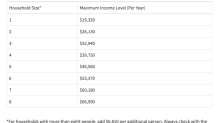
The Biden administration is distributing an additional $4.5 billion in funds to help low-income Americans cover heating costs during a second pandemic winter, with cold-weather states receiving the largest share, according to a state-by-state breakdown released Friday.
The funding boost — part of last year’s $1.9 trillion American Rescue Plan coronavirus relief package — more than doubled the normal funding level of the Low Income Home Energy Assistance Program, or LIHEAP. These funds represent the largest appropriation in a single year since the program was established in 1981.
The Associated Press obtained an advance copy of the state allocation breakdown, which shows a clear prioritization of cold-weather states with higher heating costs. For example, Minnesota received nearly $274 million in home energy assistance for needy residents. Meanwhile, Texas, which has a population five times larger, received just $10 million more. New York state, with a population of less than 20 million people compared with Texas' 29 million, received just under $876 million.
President Joe Biden's administration also announced commitments from seven major utility companies across the country to guarantee no shutoffs for customers seeking assistance and to identify and notify recipients eligible for government aid.
Get San Diego local news, weather forecasts, sports and lifestyle stories to your inbox. Sign up for NBC San Diego newsletters.
The fresh commitments, announced Friday morning, come from Atlantic City Electric, Baltimore Gas and Electric, ComEd, Delmarva Power, Pacific Gas & Electric, PECO and Pepco. They join seven other major utility companies that made similar pledges late last year.
Electricity and natural gas prices are roughly 11% higher than a year ago, according to the Labor Department’s consumer price index. Residential heating oil prices are up about 40% from a year ago, according to the Energy Information Administration. The extent of the increase has moderated in recent months as wholesale heating oil prices are roughly where they were at the start of October.
U.S. & World
The aid is meant to help cushion the shock of higher winter energy costs. But Republican lawmakers have said the overall relief package, which was signed into law by the Democratic president in March, has caused higher levels of inflation by pumping too much money into the economy.
How to apply for home energy bill assistance
To find out where to apply for federal assistance to pay for home energy bills, click here for a state-by-state information guide. You can also find a list of local agencies helping families apply for energy assistance by searching for your county here.
For more information on where you can apply for LIHEAP, call the National Energy Assistance Referral (NEAR) project's toll-free number at 1-866-674-6327 Monday through Friday, from 9 a.m. ET - 7 p.m. ET. You can also email your questions to energy@ncat.org.
Who is eligible for the program?
Anyone who needs who financial assistance with home energy costs is eligible for this program.
If you or a family member in your household currently participates in certain other government benefit programs, such as SNAP, Supplemental Security Income (SSI) and Temporary Assistance for Needy Families (TANF), you may be automatically eligible.
To be eligible, you must have an annual household income (before taxes) that is below the following amounts:

Will my whole utility bill get covered under the program?
Probably not. LIHEAP is not meant to pay for all of your energy costs for the year, the season, or even the month.
In many states, you can get help only with your main heating source. For example, if your home is heated with gas, you would likely only get help with your gas bill but not your electric bill since that powers other utilities. So, you might get help with one bill or the other.
Because of the way the LIHEAP funds are distributed, some states receive more LIHEAP funds than others, and are able to pay higher benefits.
The highest benefits go to those households that have the highest home energy costs or needs, taking into account income and family size. The amount of help that you get will depend on where you live, your income, your energy costs or needs and your family size.
Can LIHEAP help pay for other home bills?
No. LIHEAP funds can only be used to help you pay to heat or cool your home. Generally, LIHEAP funds may not be used to pay water, sewer or phone bills. One exception is when water is used for air conditioning, such as in an evaporative cooler. In this case, LIHEAP funds can be used to pay for water bills.
Can LIHEAP help me fix my furnace or air conditioner?
Yes. The energy assistance program funds can be used to help fix broken or inefficient furnaces or air conditioners. However, not every state offers this type of help and those that do have different rules about who is eligible. Check with your states' program or local county agency for qualifications.
___
Associated Press writers Ashraf Khalil and Josh Boak contributed to this report.



